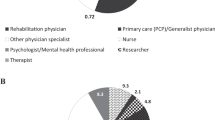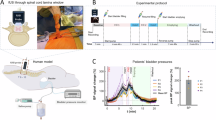Abstract
Study design: A retrospective study of patients with motor complete spinal cord lesion and somatosensory preservation (American Spinal Injury Association (ASIA) impairment scale B).
Objective: To determine whether neuropathic bladder dysfunction is more or less severe with more or fewer complications in patients with somatosensory preservation.
Setting: 2nd Department of Physical and Rehabilitation Medicine, Neuropathic Bladder Unit, National Rehabilitation Center, EIAA, Athens, Greece.
Methods: The classification of spinal cord injured patients was determined according to ASIA protocol. All patients underwent urodynamics and retrograde cystography, with a follow-up period of at least 18 months. The study sample consisted of 154 patients: 28 ASIA B patients compared with 126 ASIA A patients. We analyzed 140 traumatic and 14 nontraumatic lesions for (1) specific type of neuropathic bladder, (2) detrusor overactivity volume and pressure, (3) bladder compliance, (4) vesicoureteric reflux, (5) formation of bladder stones, (6) method of bladder emptying and (7) daily dose of anticholinergics needed to achieve safe bladder function. We also studied the presence of spasticity, autonomic dysreflexia and pain syndrome.
Results: Statistically significant differences were found between ASIA A and B patients in daily dose of anticholinergics needed to achieve safe bladder function, in the incidence of incontinence episodes and in formation of bladder stones.
Conclusion: Patients with somatosensory incomplete lesion of spinal cord seem to have an advantage in the management of neuropathic bladder dysfunction (fewer anticholinergics needed, fewer incontinence episodes and fewer bladder stones).
Similar content being viewed by others
Log in or create a free account to read this content
Gain free access to this article, as well as selected content from this journal and more on nature.com
or
References
Ku JH . The management of neurogenic bladder quality of life in spinal cord injury. BJU Int 2006; 98: 739–745.
McGuire EJ, Woodside JR, Borden TA, Weiss RM . Prognostic value of urodynamic testing in myelodysplastic patients. J Urol 1981; 126: 205–209.
Yokoyama O, Hasegawa T, Ishiura Y, Ohkawa M, Sugiyama Y, Izumida S . Morphological and functional factors predicting bladder deterioration after spinal cord injury. J Urol 1996; 155: 271–274.
Van Kerrebroeck PE, Koldewijn EL, Scherpenhuizen S, Debruyne FM . The morbidity due to lower urinary tract function in spinal cord injury patients. Paraplegia 1993; 31: 320–329.
Ku JH, Choi WJ, Lee KY, Jung TY, Lee JK, Park WH et al. Complications of the upper urinary tract in patients with spinal cord injury: a long-term follow-up study. Urol Res 2005; 33: 435–439.
Maynard Jr FM, Bracken MB, Creasey G, Ditunno Jr JF, Donovan WH, Ducker TB et al. International Standards for Neurological and Functional Classification of Spinal Cord Injury. American Spinal Injury Association. Spinal Cord 1997; 35: 266–274.
Hilz MJ, Dutsch M . Quantitative studies of autonomic function. Muscle Nerve 2006; 33: 6–20.
Nagarajarao HS, Kumar BN, Watt JW, Wiredu E, Bhamidimarri K . Bedside assessment of sympathetic skin response after spinal cord injury: a brief report comparing inspiratory gasp and visual stimulus. Spinal Cord 2006; 44: 217–221.
Craggs MD . Pelvic somato-visceral reflexes after spinal cord injury: measures of functional loss and partial preservation. Prog Brain Res 2006; 152: 205–219.
Schmid DM, Curt A, Hauri D, Schurch B . Clinical value of combined electrophysiological and urodynamic recordings to assess sexual disorders in spinal cord injured men. Neurourol Urodyn 2003; 22: 314–321.
Abrams P, Cardozo L, Fall M, Griffiths D, Rosier P, Ulmsten U et al. The Standardisation of Terminology of Lower Urinary Tract Function: Report from the Standardisation Sub-committee of the International Continence Society. Neurourol Urodyn 2002; 21: 167–178.
Madersbacher H . The various types of neurogenic bladder dysfunction: an update of current therapeutic concepts. Paraplegia 1990; 28: 217–229.
Wyndaele JJ, Madersbacher H, Kovindha A . Conservative treatment of the neuropathic bladder in spinal cord injured patients. Spinal Cord 2001; 39: 294–300.
Schurch B, Schmid DM, Karsenty G, Reitz A . Can neurologic examination predict type of detrusor sphincter-dyssynergia in patients with spinal cord injury? Urology 2005; 65: 243–246.
Weld KJ, Graney MJ, Dmochowski RR . Clinical significance of detrusor sphincter dyssynergia type in patients with post-traumatic spinal cord injury. Urology 2000; 56: 565–568.
Ord J, Lunn D, Reynard J . Bladder management and risk of bladder stone formation in spinal cord injured patients. J Urol 2003; 170: 1734–1737.
Wyndaele JJ . Investigation of the afferent nerves of the lower urinary tract in patients with ‘complete’ and ‘incomplete’ spinal cord injury. Paraplegia 1991; 29: 489–494.
Schmid DM, Reitz A, Curt A, Hauri D, Schurch B . Urethral evoked sympathetic skin responses and viscerosensory evoked potentials as diagnostic tools to evaluate urogenital autonomic afferent innervation in spinal cord injured patients. J Urol 2004; 171: 1156–1160.
Curt A, Rodic B, Schurch B, Dietz V . Recovery of bladder function in patients with acute spinal cord injury: significance of ASIA scores and somatosensory evoked potentials. Spinal Cord 1997; 35: 368–373.
Schurch B, Schmid DM, Kaegi K . Value of sensory examination in predicting bladder function in patients with T12-L1 fractures and spinal cord injury. Arch Phys Med Rehabil 2003; 84: 83–89.
Fowler CJ . Integrated control of lower urinary tract—clinical perspective. Br J Pharmacol 2006; 147 (S2): 14–24.
Author information
Authors and Affiliations
Corresponding author
Rights and permissions
About this article
Cite this article
Rapidi, CA., Petropoulou, K., Galata, A. et al. Neuropathic bladder dysfunction in patients with motor complete and sensory incomplete spinal cord lesion. Spinal Cord 46, 673–678 (2008). https://doi.org/10.1038/sc.2008.16
Received:
Revised:
Accepted:
Published:
Issue date:
DOI: https://doi.org/10.1038/sc.2008.16



